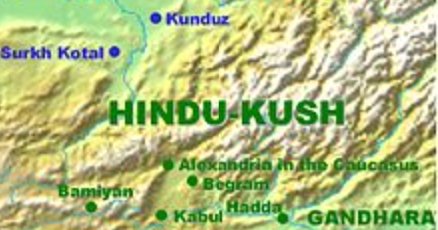How upariśyena became Hindu Kush?


In Vedic Sanskrit, the range was known as upariśyena, and in Avestan, as upāirisaēna. It can alternatively be interpreted as “beyond the reach of eagles”.
How did they come to be known as the Hindu Kush then?
The term Hindu Kush means ‘Hindu killer’, with Kush being a soft variant of the Avestan ‘Kaush’ meaning kill or killer. The Hindu Kush mountain passes connected the slave markets of Central Asia with slaves seized in the Indian subcontinent. The seizure and transportation of slaves from the Indian subcontinent became intense in and after the 8th century CE, with evidence suggesting that the slave transport involved “hundreds of thousands” of slaves from India in different periods of Islamic rule era.
https://twitter.com/DeepakInsights/status/1644319916735037440?t=ygTYLBm0HLbNjcA0xyQtHQ&s=08
According to John Coatsworth and others, the slave trading operations during the pre-Akbar Mughal and Delhi Sultanate era “sent thousands of Hindus every year north to Central Asia to pay for horses and other goods”. According to Clarence-Smith, the practice was curtailed but continued during Akbar’s era, and returned after Akbar’s death. The practice of raiding tribes, hunting, and kidnapping people for slave trading continued through the 19th century, at an extensive scale, around the Hindu Kush.
According to a British Anti-Slavery Society report of 1874, the governor of Faizabad, Mir Ghulam Bey, kept 8,000 horses and cavalrymen who routinely captured non-Muslims as well as Shia Muslims as slaves. Others alleged to be involved were feudal lords such as Ameer Sheer Ali. Before Islamic rule, foreign travelers like Megasthenes (in his treatise Indica) noted that they failed to see any slaves in India and declared that all Indians were free. Here’s how Andre Wink ties the formation of Islamic empires in the Indian subcontinent with slavery
Sending Hindu slaves to Central Asian markets formed an important part of the empire-building efforts made by the foreign Muslim invaders, the Delhi Sultanate and the Mughal dynasties. In fact, this slave trade started as early as the first Islamic invasion of India led by Muhammad al-Qasim. Owing to the Hindus being identified as kafirs or non-believers in Muslim societies, Hindus were especially in demand in the early modern Central Asian slave markets, along with Europeans, Shia Iranians, and Zoroastrians. The Bukharan waqfnama (1326) lists multiple times the presence of Hindu slaves, while another similar document (1489) from the archive of Sheikh Khwaja Ahrar talks about Hindu slaves working as artisans and laboring in farms.
There are also mentions of Hindu slaves among the Turkic pastoral groups, found documented in the historical records of a war victory of the Uzbek ruler Shibani Khan over Tanish Sultan. The Hindus were taken to Central Asian slave markets in large numbers in a variety of ways. As documented in various commercial records, many slaves were brought by caravan traders, who bought them directly as slaves or received them in barter for other goods (such as horses). As documented by a Portuguese Jesuit missionary Father Antonio Monserrate (1581), the Punjabi tribe Ghakkars so often bartered Hindu slaves in exchange for Central Asian horses that it gave rise to the proverb, “slaves from India and horses from Parthia”.
The Central Asian slave markets saw an exponential rise in Hindu slaves after Shah Jahan’s defeat in Balkh (1646-47), following which many Hindu soldiers in the defeated Mughal army were taken away as slaves to Samarqand, Turkestan, and Tashkent. They were taken in such huge numbers that a 33 year old Hindu male slave, who would have normally fetched a price of 225 tanga in Samarqand in 1589, after the 1647 Timurid defeat was getting a price as low as 84 tanga. In rare cases, skilled Hindu artisans were sent as gifts (slaves) to Central Asia by Muslim rulers in India. Hindu travelers and traders on the way to Central Asia were also kidnapped and sold as slaves. Such Hindu slaves were reported by Babur, who saw 200-300 Hindu families living as slaves in Afghanistan, involved in catching birds as their livelihood. Wars and tax revenue policies of Muslim rulers were the main factors behind the exponential rise in trade of Hindu slaves.
Mahmud of Ghazni captured around 100,000 Hindu youths during his invasion of Peshawar in 1001, and returned with so many Hindu slaves after his 12th raid into India that their market value per head was reduced to only 2-10 dirhams.Alauddin Khalji institutionalized the system of forced abduction and enslavement of Hindus who failed to pay their taxes. This policy continued into the Mughal era and worsened under Shah Jahan. Muslim rulers also increased their Hindu slave numbers when they went to war. As per Barani, Alauddin Khalji owned around 50,000 slave-boys, and another 70,000 slaves were forced into various architectural works, while Firuz Tughluq owned 180,000 slaves.
The Fatawa-e-Alamgiri framed under Aurangzeb’s orders (late 17th century) holds a compilation of the laws (Hanafi-based sharia law) for the Mughal Empire, which included the laws on slavery.Some of the slavery-related law are:
Besides the Hindu men forced into enslavement, even more horrific were the conditions of the Hindu women and children captured by these Muslim armies, who were turned into sex slaves and sold in central Asian markets. The name of the mountain range, Hindu Kush, thus encapsulates the tale of centuries of enslavement, looting, and killings of Hindus.
Credit- @DeepakInsights
DISCLAIMER: The author is solely responsible for the views expressed in this article. The author carries the responsibility for citing and/or licensing of images utilized within the text.
